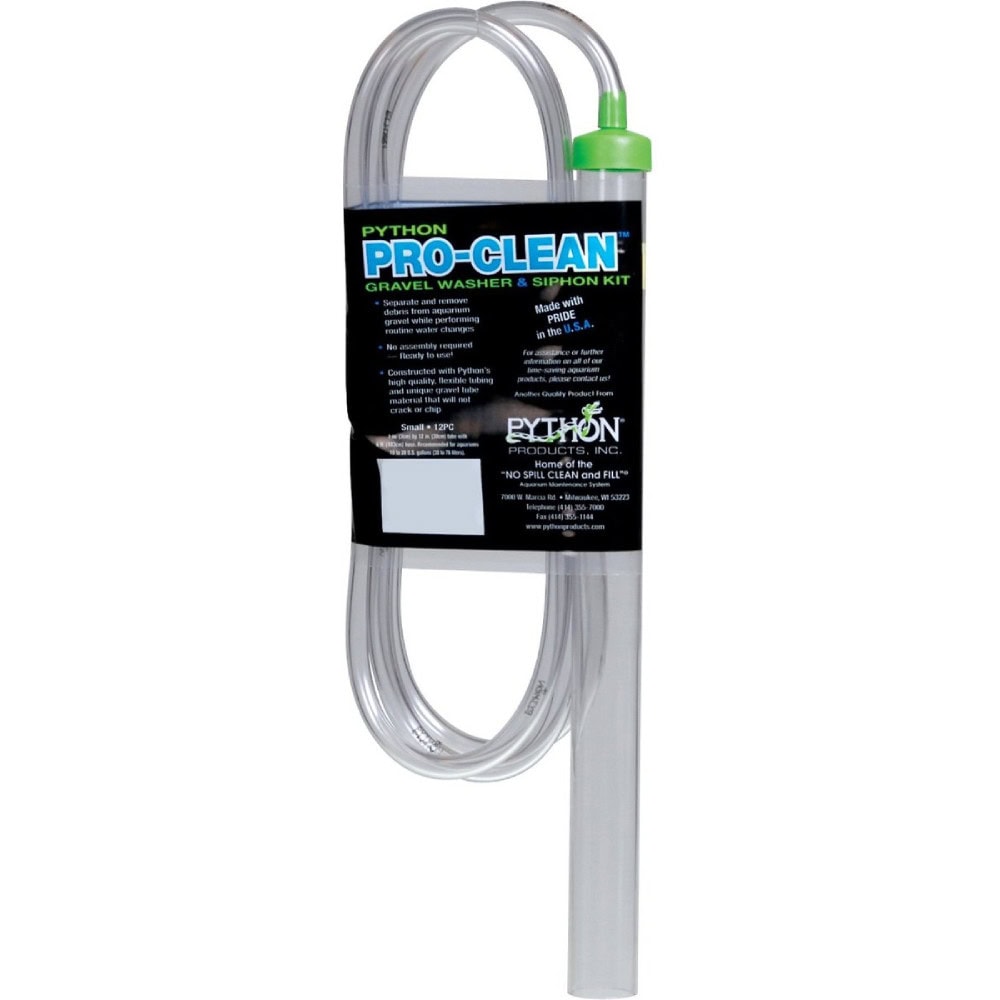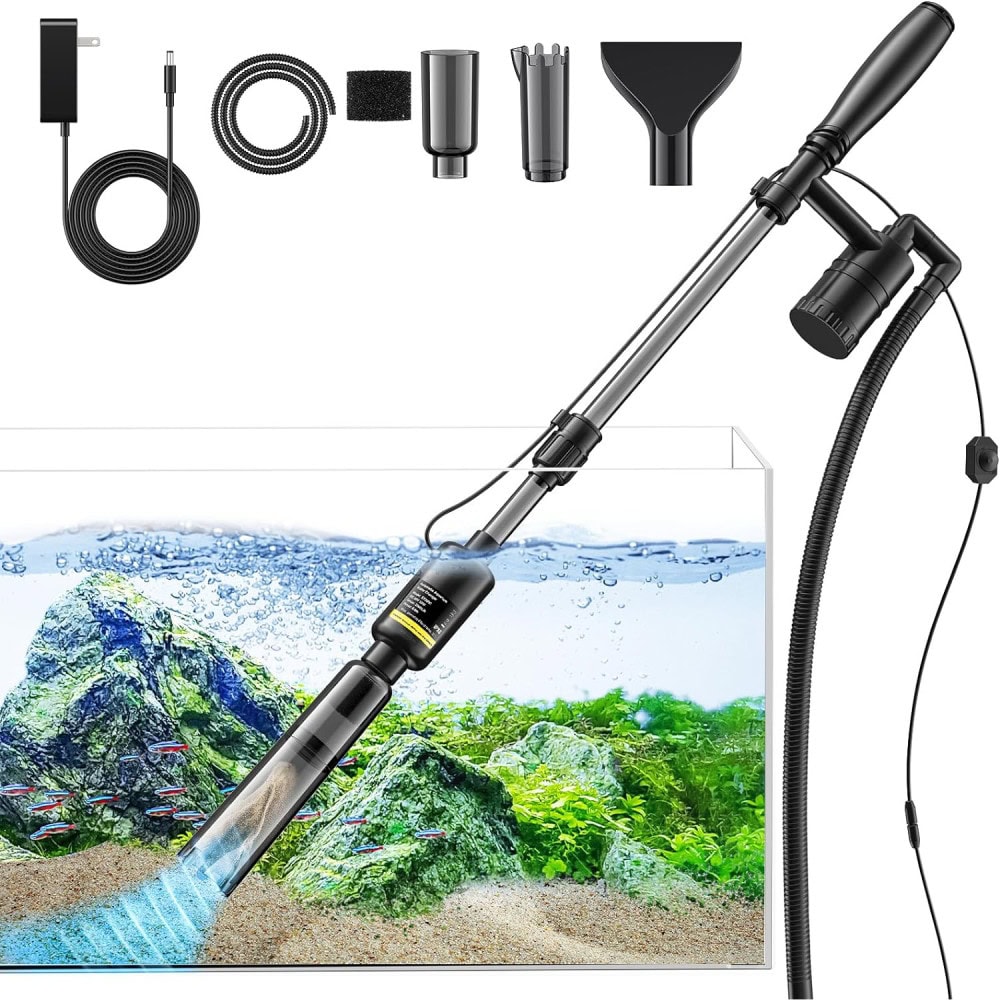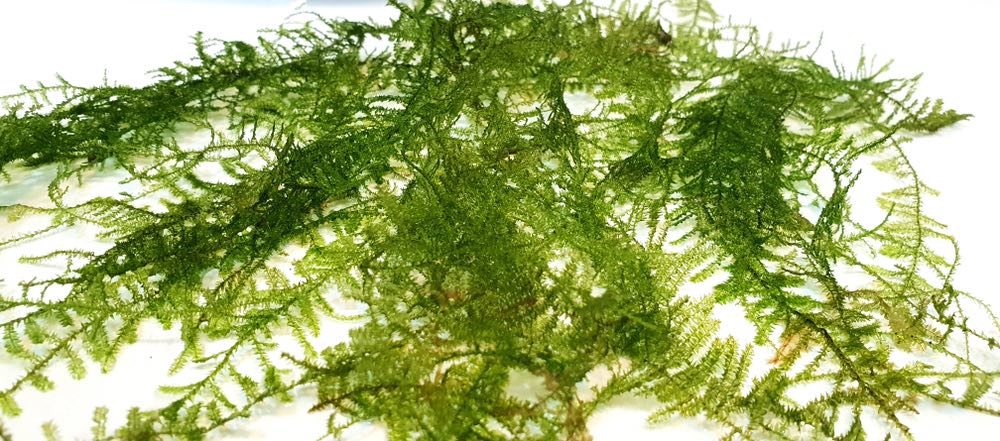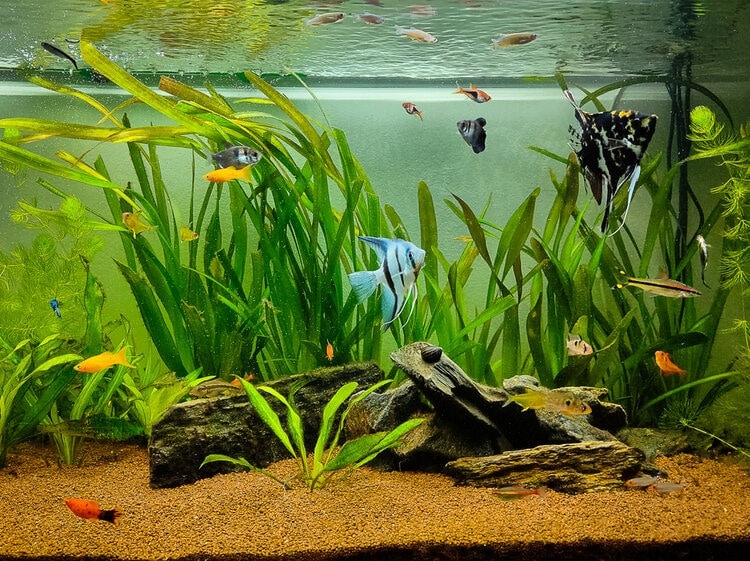10 Best Aquarium Vacuums For Sand – 2024 Reviews & Top Picks
By Grant Piper
Updated on

Here are 10 of the best aquarium vacuums for sand this year, including reviews, top picks for a variety of categories, and a buyer’s guide.

A Quick Comparison of Our Favorites in 2024
| Rating | Image | Product | Details | |
|---|---|---|---|---|
| Best Overall |
 |
Python Pro-Clean Gravel Washer & Siphon Kit for Aquariums |
|
Check Price |
| Best Value |

|
SunGrow Aquarium Siphon Vacuum Cleaner |
|
Check Price |
| Premium Choice |

|
Fish Tank Cleaner - Aquarium Gravel Cleaner |
|
Check Price |

|
TeraPump Aquarium Gravel & Sand BPA-Free Pump |
|
Check Price | |

|
Fluval GravelVAC Multi Substrate Cleaner Small |
|
Check Price |
The 10 Best Aquarium Vacuums for Sand
1. Python Pro-Clean Gravel Washer & Siphon Kit for Aquariums – Best Overall
| Power: | Manual |
| Motor: | None |
| Material: | Plastic |
The Python Pro-Clean Gravel Washer & Siphon Kit for Aquariums is the perfect combination of affordability, functionality, and durability. The Python Pro-Clean Gravel Washer & Siphon Kit for Aquariums is made in the United States from a unique type of gravel plastic that is crack and chip resistant. It comes in one single piece that does not require assembly and only minimal maintenance. It also includes a large gravel and sand tube that makes cleaning large amounts of substrate easy with just a few pumps. It even comes in five distinct sizes for tanks of all kinds.
You can get this vacuum in miniature, small, medium, large, and extra large. This allows you to buy the size that fits your needs perfectly. Other vacuums often only come in one size. All of these things together make the Python Pro-Clean Gravel Washer & Siphon Kit for Aquariums simple, effective, and well worth the money and the best overall aquarium vacuum for sand. It is an all-around great vacuum that will work for nearly any fish tank, providing you buy the right size.
One thing to look out for is that it does not include a sand or gravel screen. That means if you pump too quickly, you could end up accidentally sucking up sand and gravel that you did not intend to. This can be easily mitigated with the flow regulator, but it is something to keep in mind.
- Doesn’t require assembly
- Easy to maintain
- Comes in many different sizes
- Does not include sand and gravel screen
2. SunGrow Aquarium Siphon Vacuum Cleaner – Best Value
| Power: | Manual |
| Motor: | None |
| Material: | Plastic |
Some aquarium vacuums can be quite expensive. Many people are curious about aquarium vacuums and how they work. Do they actually clean sand? How easy are they to use? Sometimes the only way to really answer these questions is to buy one for yourself and try it out. But it can be hard to pull the trigger on a test product because of the cost. The good news is that you can get a standard manual hand vacuum for aquariums super cheap.
The SunGrow Aquarium Siphon Vacuum Cleaner is available for a pittance compared to some other systems and gives you a functional aquarium vacuum without breaking the bank. The SunGrow Aquarium Siphon Vacuum Cleaner comes with a nozzle net, flow regulator, and corrugated outflow tube. It can also be used in freshwater or saltwater tanks. We think it is the best aquarium vacuum for sand for the money.
The only downside is that this simple pump vacuum may not clean as well as some other choices. It will not suck up gravel from the substrate, but it is not as good at cleaning which can be expected at this price as it is one of the cheapest available and still functions well. It may be better for smaller tanks as opposed to larger ones.
- Affordable
- Functional
- Flow regulator included
- Adjustable outflow tube
- Doesn’t clean as well as other vacuums
3. Aquarium Gravel Cleaner, Electric Tank Cleaning Tool – Premium Choice
| Power: | Electric |
| Motor: | 32 W |
| Material: | Plastic |
The Aquarium Gravel Cleaner, 530GPH/32W Electric Fish Tank Cleaning Tool, is one of the most powerful aquarium vacuums on the market. This vacuum can move water at a very high rate. It can drain 530 gallons per hour, which is nine 55-gallon tanks per hour. It also includes a 32-Watt motor, which is nearly double the average vacuum motor’s strength. Most aquarium vacuums are just 20 Watts (or less).
This vacuum also includes a telescoping tube which makes cleaning tanks of any size a breeze. The Aquarium Gravel Cleaner, 530GPH/32W Electric Fish Tank Cleaning Tool, includes a specialized sand washing head, which is great for both rough and fine sand. The sand washing head includes a sponge filter, which increases efficiency.
The biggest downside to the Aquarium Gravel Cleaner, 530GPH/32W Electric Fish Tank Cleaning Tool is the lack of documentation. The instructions are not clear which can make assembly and cleaning a hassle if it does not seem intuitive to you.
- Super powerful motor results in good suction
- High flow rate
- Telescoping tube for a variety of tanks
- Sand cleaning tool included
- Poor documentation
4. TeraPump Aquarium Gravel & Sand BPA-Free Pump
| Power: | Manual |
| Motor: | None |
| Material: | BPA free plastic and glass |
Many aquarium vacuums are made from standard plastics that are not free from BPA chemicals. If you clean your tank a lot, you might want to consider getting a BPA free vacuum that will prevent these chemicals from slowly leaking into your tank over time. The TeraPump Aquarium Gravel & Sand BPA-Free Pump uses BPA free plastic and a sand cleaning nozzle to keep your tank as clean as possible. It also includes a flow control valve so you can easily monitor your progress in different sized tanks and a filtration system that makes cleaning and maintaining this vacuum easier than ever. The TeraPump Aquarium Gravel & Sand BPA-Free Pump can be used in saltwater or freshwater tanks and has a manual flow rate of 1.5 gallons per minute.
The only issue with this product is that the flow control piece is a little flimsy (as it is not a true valve), and it can be difficult to get started. Once the pump is primed and flowing, it moves water fairly quickly but works better as a sand cleaner or gravel scrubber than a full drainage system.
- BPA free plastic
- Includes a sand cleaning nozzle
- Flow control possible
- Can be used in salt or freshwater
- Double patented filtration system
- Flow control is a little flimsy
- Can be tricky to get primed and started
5. Fluval GravelVAC Multi Substrate Cleaner Small (50cm)
| Power: | Corded electric |
| Motor: | 32 W |
| Material: | Plastic and metal |
Many aquarium vacuums come with long cords and tubes. If you only have a small tank, these extra tubes and cords can be a hassle. You don’t need all of that for a small fish tank. That is where the Fluval GravelVAC Multi Substrate Cleaner Small (50cm) comes in. This aquarium vacuum is only 20 inches long, which is great for small tanks, and is compact and easy to handle. It has a flow regulator so you can control the flow of small tanks. It also has a gravel filter to prevent clogs. This vacuum can be used on saltwater or freshwater tanks without any issues. (Other vacuums can struggle with salt water due to the corrosive nature of salt.)
Some users reported that the suction was excellent for water transfer but was not great for cleaning substrate. That can be disappointing for people looking to use this for cleaning sand exclusively.
- High flow rate for a manual vacuum
- Small compact design is great for small tanks
- Flow regulator makes draining small tanks easy and precise
- Gravel filter prevents clogs before they happen
- Not great removing stuck on substrate material
6. bedee Electric Vacuum Gravel Cleaner 3-grade Control
| Power: | Corded electric |
| Motor: | 24 W |
| Material: | Plastic |
The bedee Electric Aquarium Vacuum Gravel Cleaner 3-grade Control is the best premium fish tank vacuum available. It comes with multiple accessories, including a manure shovel for scraping poop off the bottom of the tank. It has a control module that allows you to adjust the power for different jobs and even set a timer for easy draining.
The bedee Electric Aquarium Vacuum Gravel Cleaner 3-grade Control can vacuum and clean both coarse sand and fine sand, which is a big plus. That is due to the inclusion of two different sized cleaning tubes for different variations of sand. The tube also extends, allowing you to clean tanks of many different sizes, from small bowls to expansive tanks with dozens of gallons of water. All of these features give you some of the best value and flexibility for your money.
The biggest downside to this pump is that despite the 24 W motor, there is some concern about the overall suction strength. This can be an issue for tanks that are incredibly dirty or ones where you have pockets of firm gunk on the bottom. There are more powerful vacuums available, even if they don’t have all of the functionality of this vacuum.
- Control module included
- Tons of accessories included
- Can clean coarse or fine sand
- Extendable rod is great for large tanks
- Suction power isn’t as good as some other products
- Pricey
7. fishkeeper 20W 320GPH Aquarium Gravel Cleaner
| Power: | Corded electric |
| Motor: | 20 W |
| Material: | Plastic |
If you are looking for a powerful powered vacuum with a good flow rate, you should consider the fishkeeper 20W 320GPH Aquarium Gravel Cleaner. This aquarium vacuum can move 320 gallons of water per hour, which makes cleaning tanks, especially small tanks, fast and easy. This kit includes a sand washing head, which is perfect for cleaning the sand at the bottom of the tank. It also includes a tank brush, a filter, and an adjustable length tube. The fishkeeper 20W 320GPH Aquarium Gravel Cleaner allows you to change water or vacuum sand quickly and easily for tanks of nearly any size.
Users have complained about the short power cord, which often needs an extension cord to reach the fish tank. It lacks detailed documentation which can make assembly and cleaning a hassle. Assembly can be confusing without good documentation.
- Sand cleaning head included
- Adjustable tube for tanks of any size
- High flow rate and 20 W motor
- Rapidly cleans sand and drains water
- Short power cord
- Poor documentation
8. EHEIM Vac Pro Automatic Gravel Cleaner and Sludge Extractor
| Power: | Battery |
| Motor: | N/A |
| Material: | Plastic |
Many vacuums require a number of hoses and cords that can make cleaning your aquarium a chore. The EHEIM Quick Vac Pro Automatic Gravel Cleaner and Sludge Extractor does not require any hoses or cords. It is battery powered and has an internal tank that holds any water and gunk that you might pick up. It also has a cleanable filter that makes resetting your vacuum after use easier than ever. This vacuum also has a fairly large range. It is submersible in up to 3 feet of water, which is more than enough for all but the largest tanks.
The downside is the fact that this product is very long, which can make it cumbersome to use (but that can also be a pro if you are using it in a deep tank). It also seems to have some problems with the seals, which occasionally causes water to leak out. If the water gets into the battery compartment, it can fry the unit, so that is something you need to be careful of while using the EHEIM Quick Vac Pro Automatic Gravel Cleaner and Sludge Extractor.
- Battery powered
- No hoses or cords required
- Long reach can go into 3 feet of water
- Easy to clean filter
- Problems with leaking can cause battery problems
- Long length can be cumbersome
9. SunGrow Gravel Cleaner Vacuum Pump & Tank Water Changer
| Power: | Manual |
| Motor: | None |
| Material: | Plastic |
The SunGrow Gravel Cleaner Vacuum Pump & Tank Water Changer Betta Fish Aquarium Siphon by SunGrow is the perfect aquarium vacuum for small betta fish tanks. Betta fish require a spotless tank, and this is the perfect vacuum to clean sand and gravel in your betta fish aquarium. This vacuum has a filter that prevents you from sucking up your betta fish, plants, or sand by accident. Even though you don’t typically need a large vacuum for a betta fish, this vacuum has a 65-inch tube assembly, which makes cleaning the tank easier than ever.
The only downside is with the overall durability. This vacuum is prone to having its seal separate, which can lead to leaks and decreased efficiency over time. As long as you are careful with the SunGrow Gravel Cleaner Vacuum Pump & Tank Water Changer Betta Fish Aquarium Siphon by SunGrow you shouldn’t have any issues. Also, be sure to store it properly (not in the sun or in a cool, dark place).
- Perfect for small betta fish tanks
- Plenty of hand powered suction
- Filter prevents you from sucking up things you don’t want
- Some quality issues reported
10. PearlSea Electric Aquarium Gravel Cleaner: 6 in 1 Electric Vacuum
| Power: | Corded electric |
| Motor: | 6 W |
| Material: | Plastic |
The PearlSea Electric Aquarium Gravel Cleaner: 6 in 1 Electric Fish Tank Vacuum Gravel Cleaner comes with many features that make it great for cleaning out large tanks. First off, this vacuum is quite large. It measures nearly 48 inches long and can be submerged up to 3 feet. This vacuum also comes with a sand washing head and a gravel scrubbing head. The length plus the accessories means you can easily wash the sand on the bottom of a large tank without getting wet. It also includes a double filtration system featuring two sponge filters on the inlet and outlet areas, which allows you to cycle your water effectively in addition to being able to wash your sand.
The two biggest downsides to the PearlSea Electric Aquarium Gravel Cleaner: 6 in 1 Electric Fish Tank Vacuum Gravel Cleaner is that the length can be a bit cumbersome in tight quarters and that the motor is not as strong as others. This vacuum provides a respectable 95 gallons per hour of flow but only boasts a 6 W motor, which is less than many other electric vacuums.
- Long wand is great for large tanks
- Comes with a gravel scrubber and sand washing attachment
- Double filtration system for effective water cycling
- Hard plastic construction
- Wand can be difficult to wield
- Under powered motor

Buyer’s Guide: Choosing The Best Aquarium Vacuums for Sand

Flow Rate
One of the things that you have to look for in an aquarium vacuum is the flow rate. Flow rates come in two different units. You have gallons per minute (GPM) and gallons per hour (GPH). Gallons per minute is usually used on hand siphons that move water much more slowly than motorized vacuums. If you see a vacuum advertising 2 GPM, that means you can pump out 2 gallons of water per minute. Larger vacuums can move much more water with rates like 100 GPH.
The flow rate is important for two reasons. First, if you are planning on using your vacuum to remove water in addition to cleaning the sand, you will want to know how quickly it will drain a tank. A hand pump moving 2 gallons of water per minute will take half an hour to empty a 55-gallon tank. That is a lot of pumping by hand. A large, motorized vacuum that can do 100 gallons per hour will also take roughly half an hour but without stressing your forearm muscles. You don’t want to buy a vacuum with a low flow rate that will take you forever to drain and clean a tank. This is especially true if you have a very large aquarium.
Motorized vs. Hand
There are two main types of aquarium vacuums. There are hand siphons and motorized vacuums. Hand siphons use bellows to manually remove water and junk from your fish tank. Hand siphons are often cheaper, more reliable, and smaller than motorized vacuums. However, they take more work and are often slower and less powerful. Motorized vacuums are more expensive and larger and need a power source (either battery or corded) to work.
Hand siphons are easier to clean and maintain compared to motorized vacuums. But motorized vacuums are much better for large fish tanks or aquariums with a lot of sand and gravel that need to be regularly cleaned or changed.
If you have a small fish tank that does not require a lot of cleaning, you can get away with a simple hand siphon. If you have a large tank (or multiple aquariums), you will likely want the convenience of the motorized vacuum.
Usage
One factor that will determine what kind of flow rate you need, or whether you want a motorized vacuum or hand siphon, will be your usage. How often are you planning on using your aquarium vacuum? How big is your tank? Do you have multiple tanks? How much sand do you use in your tank designs? These are important questions to answer. If you have large tanks (55 gallons or more), you will likely want something more heavy duty and likely motorized. If you just have a small tank with a few fish, you can probably get away with a hand siphon.
If you have plenty of algae cleaning devices in your tank (including snails and live plants), you might not need to vacuum your sand as much as someone without these mitigation methods. If you don’t plan on vacuuming your tank often, you might not need to invest in an expensive or large vacuum.
Maintenance
Another thing you want to consider is the maintenance of your vacuum. Vacuums with many parts and accessories will need more cleaning and upkeep. Motorized vacuums can have trouble with the pumps and the motors. Battery powered vacuums can lose charging capability over time. You want to get a vacuum that meets both your needs and your maintenance expectations.
If you don’t keep your vacuum properly, you can run into issues with effectiveness over time. If you don’t want to spend a lot of time disassembling, cleaning, and reassembling a vacuum system, you might want to settle for a simple siphon with just a couple of parts rather than a vacuum system with multiple tubes, extenders, and accessories.
Budget
Lastly, you want to consider your budget. How much do you want to spend on an aquarium vacuum? Are you willing to invest in replacement parts? Many vacuums can be found for $30 or less, but that won’t include the premium options or the largest and most powerful vacuums. If your budget is tight, you can find multiple options for less than $20 that should hold up just fine over time. Setting a price point will help you filter your results so that you are not drowning in options that you cannot afford or are unwilling to pay for.

Conclusion
These 10 aquarium vacuums are great for cleaning tanks, especially the sand and gravel on the bottom of each one. There are vacuums available at every price point and in a variety of different styles. You can find a simple and affordable hand pump that can be used to cycle water and sand out of a small tank quickly or a large powered vacuum that can drain and scrub large tanks in a matter of minutes.
For the best overall option, we like the Python Pro-Clean Gravel Washer & Siphon Kit for Aquariums. If you’re on a budget, the SunGrow Aquarium Siphon Vacuum Cleaner is a good starter choice. All you have to do is find the vacuum that is the best fit for your tank and your budget, and we hope you were able to do so with our reviews.
Featured Image Credit: Maheshwar Reddy, Pexels























